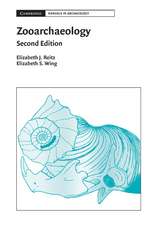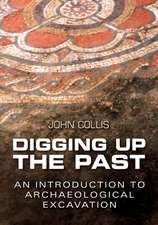Use-Wear and Residue Analysis in Archaeology: Manuals in Archaeological Method, Theory and Technique
Editat de João Manuel Marreiros, Juan F. Gibaja Bao, Nuno Ferreira Bichoen Limba Engleză Hardback – 19 noi 2014
| Toate formatele și edițiile | Preț | Express |
|---|---|---|
| Paperback (1) | 496.34 lei 43-57 zile | |
| Springer International Publishing – 24 sep 2016 | 496.34 lei 43-57 zile | |
| Hardback (1) | 530.75 lei 43-57 zile | |
| Springer International Publishing – 19 noi 2014 | 530.75 lei 43-57 zile |
Preț: 530.75 lei
Preț vechi: 624.41 lei
-15% Nou
Puncte Express: 796
Preț estimativ în valută:
101.59€ • 110.39$ • 85.39£
101.59€ • 110.39$ • 85.39£
Carte tipărită la comandă
Livrare economică 21 aprilie-05 mai
Preluare comenzi: 021 569.72.76
Specificații
ISBN-13: 9783319082561
ISBN-10: 3319082566
Pagini: 120
Ilustrații: XI, 223 p. 64 illus., 49 illus. in color.
Dimensiuni: 155 x 235 x 20 mm
Greutate: 0.51 kg
Ediția:2015
Editura: Springer International Publishing
Colecția Springer
Seria Manuals in Archaeological Method, Theory and Technique
Locul publicării:Cham, Switzerland
ISBN-10: 3319082566
Pagini: 120
Ilustrații: XI, 223 p. 64 illus., 49 illus. in color.
Dimensiuni: 155 x 235 x 20 mm
Greutate: 0.51 kg
Ediția:2015
Editura: Springer International Publishing
Colecția Springer
Seria Manuals in Archaeological Method, Theory and Technique
Locul publicării:Cham, Switzerland
Public țintă
GraduateCuprins
Chapter 1: Use-wear and residue analysis in archaeology Nuno Bicho, João Marreiros and Juan Gibaja.- Chapter 2: Macro and micro evidences from the past: The state of the art of archaeological use-wear studies João Marreiros, Niccolò Mazzucco, Juan Gibaja and Nuno Bicho.- Chapter 3: Ethnoarchaeology and functional analysis Jesus Emilio González, Sylvie Beyries and Juan José Ibáñez.- Chapter 4: Use-wear analysis on flint tools. Beyond the methodological issues Juan Gibaja and Bernard Gassin.- Chapter 5: Use-wear analysis of non-flint lithic raw materials: the cases of quartz/quartzite and obsidian Ignacio Clemente-Conte, Talía Lazuén Fernández, Laurence Astruc and Amélia Rodriguez.- Chapter 6: Keys to the identification of prehension and hafting traces Veerle Rots.- Chapter 7: Current Analytical Frameworks for Studies of Use-Wear on Ground Stone Tools Laure Dubreuil, Daniel Savage, Selina Delgado-Raack, Hugues Plisson, Birgitta Stephenson, Ignacio de la Torre.- Chapter 8: Use-Wear methodology on the analysis of osseous industry Marina Évora.-Chapter 9: Traceology on metal. Use-wear marks on copper-based tools and weapons Carmen Gutiérrez Sáez and Ignacio Martín Lerma.- Chapter 10: Pottery use-alteration analysis James M. Skibo.- Chapter 11: About small things and bigger pictures: An introduction to the morphological identification of micro-residues on stone tools Geeske Langejans and Marlize Lombard.
Notă biografică
João Marreiros is an archaeologist working as a post-doctoral researcher (FCT-grant) in the Interdisciplinary Center of Archaeology and Evolution of Human Behaviour (ICARhEB), Universidade do Algarve (Portugal) and in the Departamento de Arqueología y Antropología de la Instituición Milà I Fontanals, del Consejo Superior de Investigacionres CIentíficas (CSIC, Catalonia). He’s research focuses stone tools technology and functionality from the Early Upper Paleolithic in Western Europe, particularly on techno-typological and use-wear analysis of lithic tools from the Early Upper Paleolithic industries from Iberian Peninsula with special interest in human ecological behavior and the first evidences of Anatomical Modern Humans industries in this region. He, in collaboration with the other two editors, organized the International Conference on Use-Wear analysis 2012, held in Faro (Portugal).
Juan Gibaja received his PhD in Archaeology & Prehistory from Universidad Autónoma de Barcelona in 2002. From 2006-2011 he worked as a post-doctoral fellow at the Universidade do Algarve (Portugal) funded by Fundação para a CIência e Tecnologia (FCT). Currently, since 2011, he is an Ramón y Cajal researcher at the Departamento de Arqueología y Antropología de la Instituición Milà I Fontanals, del Consejo Superior de Investigacionres CIentíficas (CSIC). During the last decade, he headed several research projects focus on lithic use-wear analysis. His research focuses on the key transition phases from Late and Early Prehistory: the transition between the last Neanderthals and anatomically modern humans and the transition from the last hunter-gatherers from the Mesolithic to the first farmers of the Neolithic in the Occidental Mediterranean.
Nuno Bicho received his Ph.D. in Anthropology from Southern Methodist University in 1992. He is currently an Associate Professor of Archaeology at the Universidade do Algarve, Portugal. He was Deanbetween 1998 and 2001 and 2005-2007. In addition, Bicho is the Director of the Interdisciplinary Center of Archaeology and Evolution of Human Behaviour at the University of Algarve. He specializes in Paleolithic ecodynamics and his research focused on prehistoric costal hunter-gatherers of southern Iberia for the last two decades. More recently he has also developed research on the Mesolithic of the Tagus Valley and on Middle Stone Age of Mozambique.
Juan Gibaja received his PhD in Archaeology & Prehistory from Universidad Autónoma de Barcelona in 2002. From 2006-2011 he worked as a post-doctoral fellow at the Universidade do Algarve (Portugal) funded by Fundação para a CIência e Tecnologia (FCT). Currently, since 2011, he is an Ramón y Cajal researcher at the Departamento de Arqueología y Antropología de la Instituición Milà I Fontanals, del Consejo Superior de Investigacionres CIentíficas (CSIC). During the last decade, he headed several research projects focus on lithic use-wear analysis. His research focuses on the key transition phases from Late and Early Prehistory: the transition between the last Neanderthals and anatomically modern humans and the transition from the last hunter-gatherers from the Mesolithic to the first farmers of the Neolithic in the Occidental Mediterranean.
Nuno Bicho received his Ph.D. in Anthropology from Southern Methodist University in 1992. He is currently an Associate Professor of Archaeology at the Universidade do Algarve, Portugal. He was Deanbetween 1998 and 2001 and 2005-2007. In addition, Bicho is the Director of the Interdisciplinary Center of Archaeology and Evolution of Human Behaviour at the University of Algarve. He specializes in Paleolithic ecodynamics and his research focused on prehistoric costal hunter-gatherers of southern Iberia for the last two decades. More recently he has also developed research on the Mesolithic of the Tagus Valley and on Middle Stone Age of Mozambique.
Textul de pe ultima copertă
This book is designed to act as a readily accessible guide to different methods and techniques of use-wear and residue analysis, and therefore includes a wide range of different and complementary essential topics: experimental tests, observation and record methods and techniques, and the interpretation of a diversity of tool types and worked raw materials. The onset of use-wear studies was marked by the development of theory, method and techniques in order to infer prehistoric tools functionality and, therefore, understand human technological, social and cultural behavior. The last decade of functional studies, use-wear and residue analysis have been aimed at the observation, recording and interpretation of different activities and worked materials found on archaeological tools made on different types of organic and non-organic materials. This international group of contributions will be fundamental for all researchers and students of the discipline.
Caracteristici
Describes the important role of methodological and technological approaches within use-wear studies Focuses on modern use-wear analysis methods Discusses ways to extend traceology to other materials Includes supplementary material: sn.pub/extras
























